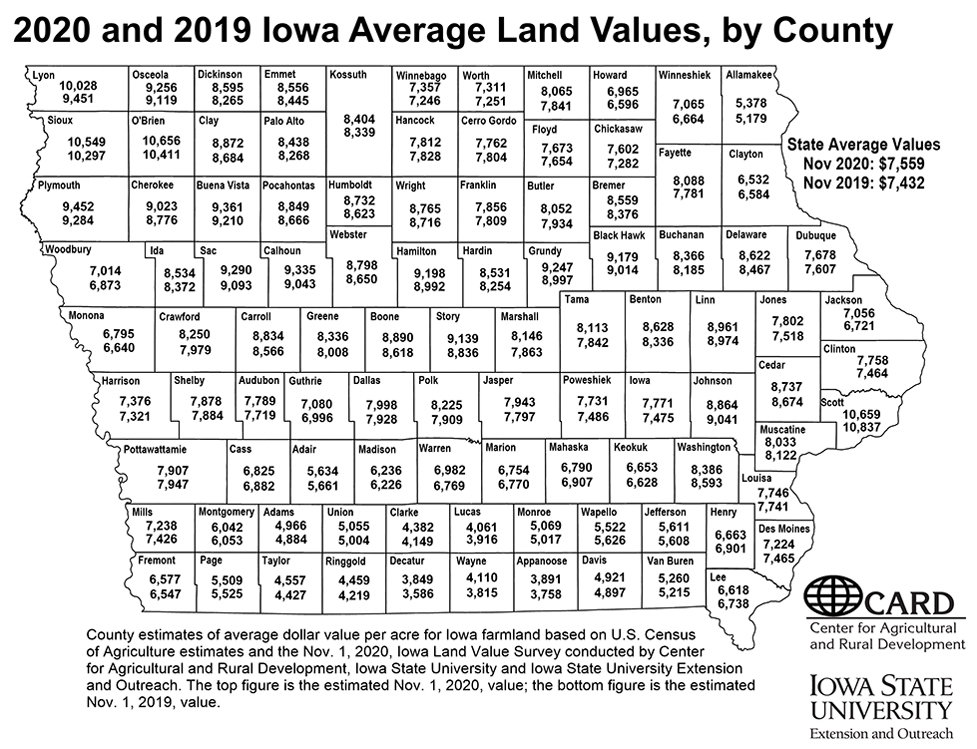Average Iowa farmland value increased 1.7 percent per acre
AMES — Favorable interest rates, a strong demand for land and substantial government payments helped stabilize Iowa’s farmland market in a year in which Iowa’s farmers faced the destructive onslaught of a derecho, significant uncertainties in U.S. agricultural trade and a pandemic that significantly altered market demand.
“The land market faced downward pressure initially with the onset of the COVID-19 pandemic, which lowered food demand and resulted in declines in livestock and ethanol prices,” said Wendong Zhang, assistant professor in economics and extension economist at Iowa State University.
This year’s Iowa Land Value Survey found that the average statewide value of an acre of farmland is $7,559, an increase of 1.7 percent, or $127, since 2019. The $7,559 per acre estimate, and 1.7 percent increase in value, represents a statewide average of low, medium and high-quality farmland.
Statewide, Iowa’s high quality farmland saw a decline in value of 0.1 percent. However, Zhang said that it’s important to note that number is more indicative of a flat market, rather than a decline, and that several factors have led to a recent rebound in the market.
“The rebound in recent months is due to strong government payments, interest rate cuts, limited land supply and recent commodity price rallies,” said Zhang, who is responsible for leading the annual survey.
In mid-November, both U.S. corn and soybean prices reached their highest point so far this year. Despite some decline since then, both prices are still higher than at the beginning of the year, especially soybeans.
“The export surges related to the phase one deal and China’s efforts to rebuild its hog herd ramped up demand for feed grains,” Zhang said.
“There is definitely concerns and downside risks about the price rallies because post-harvest prices are typically lower,” he said. However, he stressed that China is still at least 10-15 percent short of its regular hog inventory, so farmers should continue seeing increased feed grain demand.
Additionally, Germany, a key competitor for U.S. pork exports, is now battling with African swine fever, the same disease that decimated China’s hog industry, which could increase U.S. pork exports in the future.
Zhang also said that farm payments in 2020 helped prop up the farmland market “in a big way.”
Some of the increase in overall value this year is also due to increased demand for low-quality land in certain parts of the state. The overall average increase in farmland value was very modest, but low-quality land in the Northeast, West Central, South Central and Southeast districts saw increases of 8 percent or more.
“Strong demand for pasture and timber grounds, which are even more appealing now with social-distancing requirements, contributed to the rise in low-quality land value,” Zhang said.
However, he noted that when compared to high-quality land, it doesn’t take a substantial change in the dollar value of low-quality land to constitute a large percent increase in values.
Land values by county
Seventy-eight of Iowa’s 99 counties showed an increase in land values. For the eighth year, Scott and Decatur counties reported the highest and lowest values, respectively. Despite having the highest overall value, average land values in Scott County decreased $178 per acre to $10,659.
Decatur County, however, saw average values increase $264 per acre to $3,849.
Wayne County reported the largest percentage increase, 7.7 percent, while Lyon County saw the largest dollar increase, $577 per acre. The largest dollar decrease was reported in Des Moines County, $241 per acre, and the highest percentage decrease, 3.4 percent, was reported in Henry County.
In Muscatine County, average land values fell from $8,122 to $8,033. In Cedar County, average land values increased from $8,674 to $8,737.
Land values by district
The Northwest crop reporting district reported the highest land values, $9,536 per acre, and the South Central district reported the lowest, $4,658 per acre.
In general, land values across crop reporting districts increased — only the Southwest district reported a decline in land values (-0.9 percent). The largest percentage increases were in the West Central and South Central districts, 3.9 percent and 3.8 percent, respectively; however, both the Northeast and Northwest districts reported increases of 2 percent or higher.
Land values by quality
Statewide, low-quality land now averages $5,078 per acre, an increase of 6.7 percent or $319 per acre. Medium-quality land now averages $7,119 per acre, an increase of 2.6 percent or $181 per acre.
High-quality land now averages $9,068 per acre, a decrease of 0.1 percent or $10 per acre.
Only low-quality land in the North Central district showed a decline in average prices this year (-0.5 percent). Low-quality land in the Northeast, West Central, South Central and Southeast districts, however, all saw increases of 8 percent or more.
The West Central and South Central districts reported the largest gains in medium-quality land values, 5.0 percent and 4.4 percent, respectively. While no districts reported a loss in medium-quality land, the Southwest district only reported a nominal gain of $2 per acre.
High-quality land in five of Iowa’s nine crop districts saw increases of less than 2 percent, while East Central and Southwest districts reported a decline of more than 2 percent.
Factors influencing the land market
Favorable interest rates, limited land supply, and recent commodity price rallies were the most frequently mentioned positive factors influencing the land market in this year’s survey. Other positive factors respondents noted included COVID-related payments, government payments and strong demand for land, especially by farmers.
The most frequently mentioned negative factors affecting were lower commodity prices, uncertainty due to the COVID-19 pandemic and weather. Other negative factors included political uncertainty related to the 2020 election, poor yields, and general economic uncertainty.
The 2020 survey is based on 707 usable responses from 484 agricultural professionals. Sixty-seven percent of the 484 respondents answered the survey online.
Comments

